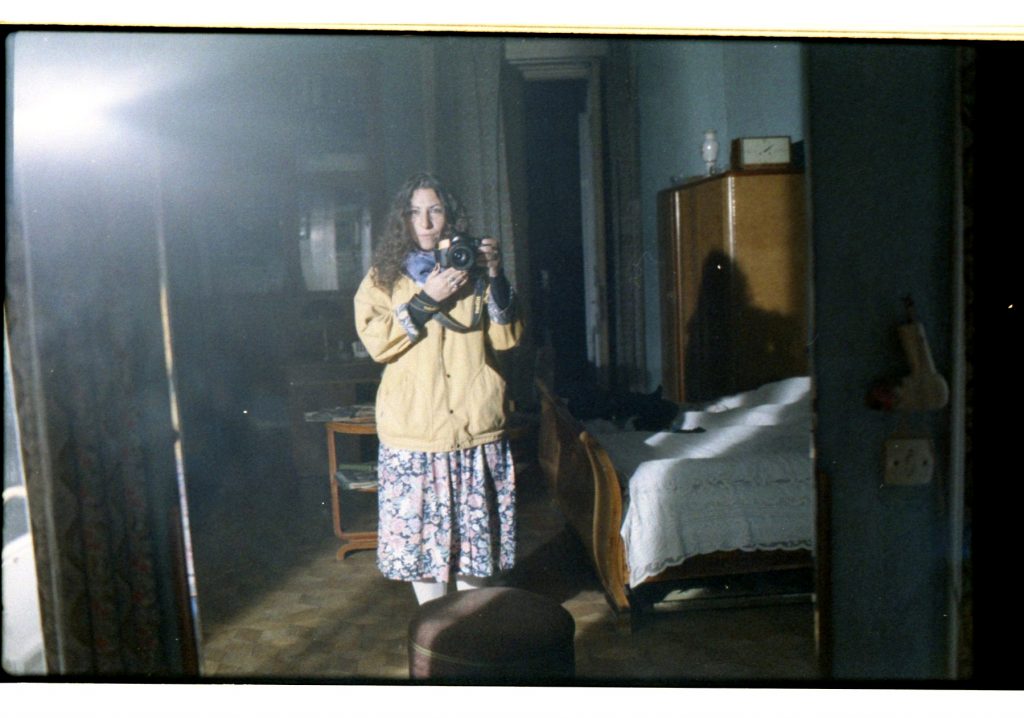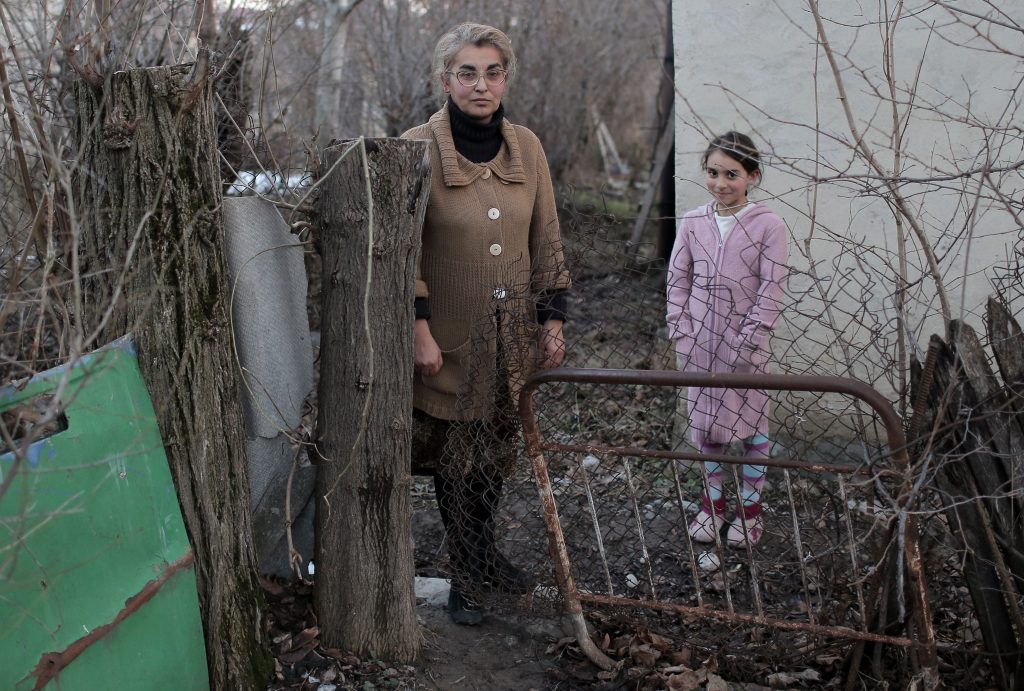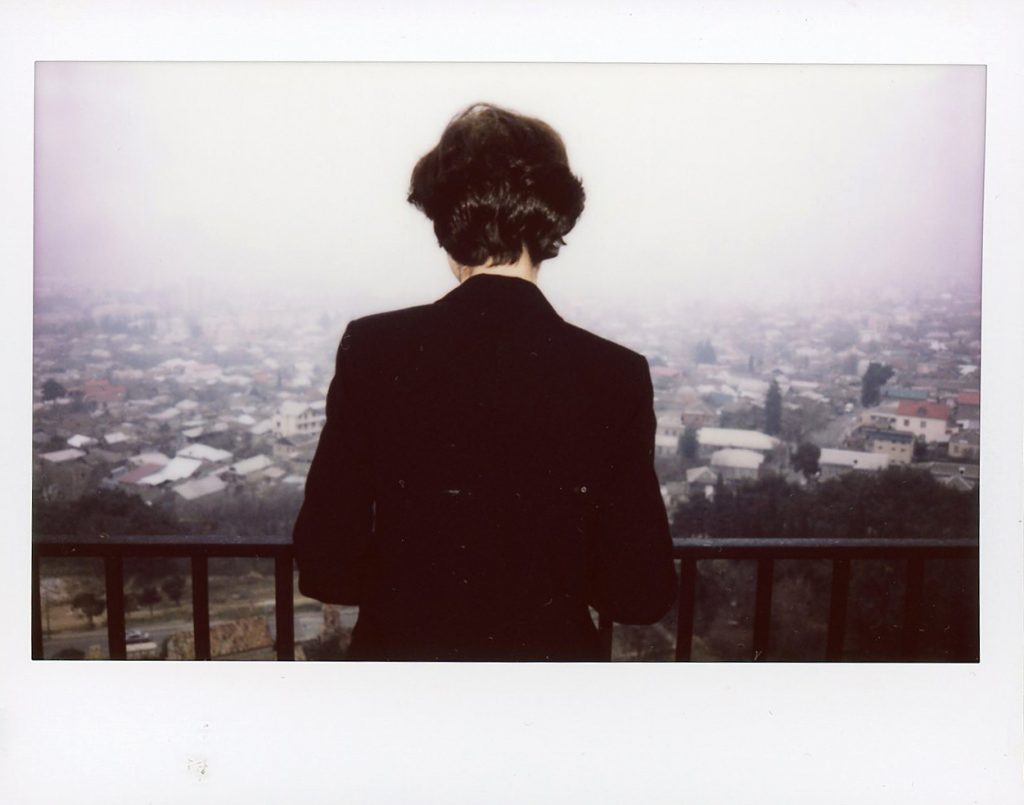By Hannah Stoddard
It was August and Dina Oganova was five years old. She and her mother had escaped Tbilisi’s humid afternoons and retreated to Borjomi, a popular mountain town famous for its mineral springs and lush scenery. They rented a room in a photographer’s guest house.
Dina had a knack for getting into trouble, and as if he sensed this propensity upon her arrival, the photographer gave her one rule: stay out of the darkroom.
“After that, of course,” Dina said, “my biggest interest in life became that room.”
When the photographer returned from work each day and shut himself in the darkroom to make photos, Dina would sit outside the room, waiting for a glimpse of the strange red light that spilled from the crack beneath the doorframe.
For several evenings, Dina waited outside, hoping to discover what kind of magic might be happening on the other side of the door. The photographer noticed her persistent interest and gave her scraps of unusable film to keep, piquing her curiosity even more.
Then, on the last evening of her stay, the door opened fully, filling the hallway with a red glow. The photographer motioned to Dina.
“Do you really want to see what is happening inside?” he said. “Come on, I’ll show you.”
Inside the room, she watched, enthralled, as dark shapes bloomed on the pure white photo paper.
“After that, my life changed,” Dina said.
As soon as Dina was old enough to own a camera, she began taking photos whenever she could. As she grew older and became more practiced, she became less fascinated with the process of developing an image. She began to understand photography as something she could do to help people share their stories. She focused on getting to know each person she photographed so the photos would speak with their voices.
“I always say I’m a lazy photographer,” Dina said. “I can’t just go somewhere and shoot something and be ready. I love to leave time just to rest and spend time with people. I start shooting very late because I want people to understand what I’m doing and know who I am and why they are letting me into their life.”

Not a war photographer
Today, Dina seeks out long-term projects that often focus on women. In a male-dominated country like Georgia, these stories are otherwise hidden, as was the case with a project she began in 2008 when she was 20 years old.
Dina was just starting out as a documentary photographer. It was August again, but she was not on summer holiday. Instead, she lay immobile in a Tbilisi hospital, recovering from a recent operation.
On the morning of August 8, Dina’s mother came to visit. The hospital wing was eerily quiet. The halls were empty. Then, without warning, a shrill scream pierced the silence.
“The war has started,” a woman cried out as she ran down the hall. “The war has started!”
After a summer of tensions, Russia had invaded Georgia, deploying tanks and troops to several cities, including to Gori, a city not far from Tbilisi.
But Dina didn’t know this. There were no televisions in the hospital.
Her mother shut the door to keep her from worrying.
“It’s nothing,” she said.
Two days later when Dina returned home from the hospital, she sat in front of the television, horrified as chaotic scenes from Gori flashed across the screen.
When someone shouted from behind the camera in a shaky clip of footage, she recognized the voice. It was her good friend, another photographer.
“They are bombing us,” he yelled, panicked. “They are bombing us!”
The first thing she could think to do was call him. There was no answer.
“Of course, that wasn’t the right thing to do,” Dina said. “I could see from the video what he was doing and he couldn’t answer the phone. But that was my first reaction.”
Under different circumstances, Dina wouldn’t have hesitated to take her camera to Gori and document the war. Many of her friends, and journalists and photographers that she knew, were in the conflict zone. She remembers feeling guilty for not being there too.
“I’m not a war photographer,” she explained. “I would never travel to a conflict zone because that’s not my topic. But when it’s happening in my country…I always say photography is what I have to help people. The camera is my gun.”
But she still couldn’t fully walk. Days later, when the fighting was over, she asked herself, “What did I do?”
No one calls it a war
The war lasted five days. 400 Georgians lost their lives. 2,000 were wounded. 20,000 were displaced.

“No one calls it a war,” said Dina. “They say it was a five-day conflict. But that’s a huge problem for me. I can’t say it’s just a conflict when I’m losing people I love.”
As soon as Dina had recovered completely from her operation, she set out for Gori with her camera.
“I wanted to do something to say this war is not finished,” Dina said. “I love my country, and it is very important for the next generation to know what happened. It was not just a conflict. We lost a lot of people, a lot of soldiers, and our territory.”
Dina visited a makeshift camp outside Gori, where people who had lost their homes were still living nearly a month after the war. She interviewed and photographed women who weren’t the subjects of heroic stories, but whose lives were no less impacted by violence and loss, to show a side of the war that hadn’t been seen.
For nearly a decade, Dina traveled back and forth from Tbilisi to camps and villages in the conflict zone, meeting women, making photos, and chronicling their stories. The more women she spoke with, the greater sense of urgency she felt to share their stories with a wider audience.
As the 10-year anniversary of the war approached, she envisioned a photobook that would compile the stories of women whose lives were changed by the war.
“I wanted it to be published,” said Dina. “I wanted the book in every bookstore, everywhere.”
Dina invited her good friend and writer, Salome Benidze, to write the text that would accompany the photos in the book.
Paying something back
In August of 1992, conflict broke out in Abkhazia, a small territory in the northeast corner of newly independent Georgia, between Abkhaz forces supported by Russia, and the Georgian government. After a period of intense fighting, the region broke away from Georgia and declared independence. Many ethnic Georgians were displaced from their homes. Since the 2008 war, there has been a steady Russian military presence in the region.
Salome’s family was originally from Abkhazia on her father’s side.
“My first memories are from Abkhazia,” Salome explained. She remembers the church where she was baptized, her grandparents’ house surrounded by trees, and her father’s grave.
“I have not seen these things since I was five,” she said. “My memories are also occupied.”
When Dina approached Salome about the book project, she agreed to collaborate immediately.
“My main inspirations were the women of my family and their experiences of war,” Salome said. “My grandmother and my mother, who were deeply influenced by the events of the 1990s. I was doing this for me, but also for them. It was like I was paying something back.”
“I’m sorry” isn’t enough
Dina and Salome traveled together to interview women who lost their husbands, who protected their children, who refused to leave their villages when the soldiers came. They didn’t have trouble finding women who wanted to share their stories.
“That’s why I love Georgia,” said Dina. “It’s really very easy to talk to people. Sometimes we would just knock on people’s doors.”
“Of course, come in. Do you want some coffee?” was often the response they received.
Once inside, Dina and Salome sat and talked with women for hours. Sometimes they didn’t even record interviews. For some of the women, it was the first time they had been asked about their experiences in the war. For many, it was necessary to tell their stories to heal.
“All the stories were so difficult for us to hear,” said Dina. “They are telling you [their stories] and it’s like you are living their life at that moment with them. We would sit and cry together.”
One woman recounted her story about surviving a night of bombings by hiding in her family’s barn. No one was with her, but a small pig. She described how she crawled into the pig’s pen and laid down. She clutched the pig to her chest and whispered to it that everything was going to be okay. She stayed like that through the night, as bombs exploded overhead.
Another woman was pregnant with her fifth child when tanks came to the village of Ergneti. She and her family fled to Gori, and when they arrived, the woman went into labor. She gave birth to a baby girl, Keto. Gori was bombed the next day.

“It was very, very difficult,” said Salome, reflecting on the experience of conducting interviews. “These women are telling you about the worst days of their lives and you’re standing there with a voice recorder. ‘I’m sorry’ isn’t enough in these situations.”
You are not alone
“sHEROes” was published in 2018. It tells the stories of 60 women, all of different backgrounds and ages.

Dina hopes its portraits help Georgians feel connected to the women and their stories.
“We used portraits because when we were telling women’s stories, we wanted people to know their faces,” said Dina. “If people meet these women in the street, they will say, ‘Hey, we know your story. We know who you are. You are not alone.’”
For Dina, the connections she made with the women are just as important as the awards and praise the book received after it was published.
“I’m here,” said Dina. “They can always call me, they can always write to me. There is not one person [whose portrait] I shot that we would not hug if we saw each other in the street. Photography is a relationship first, then something else.”